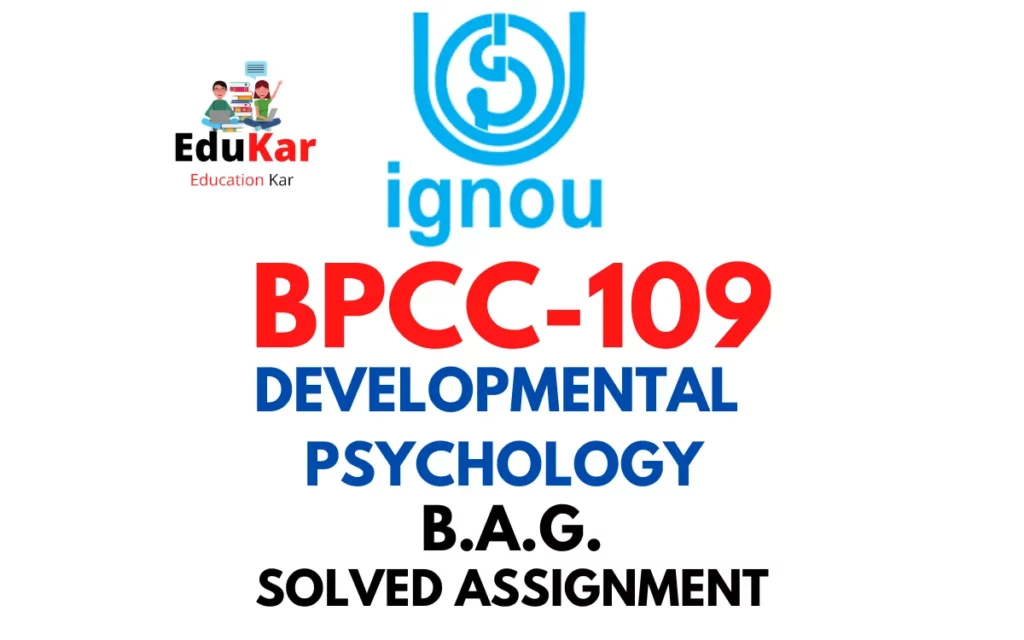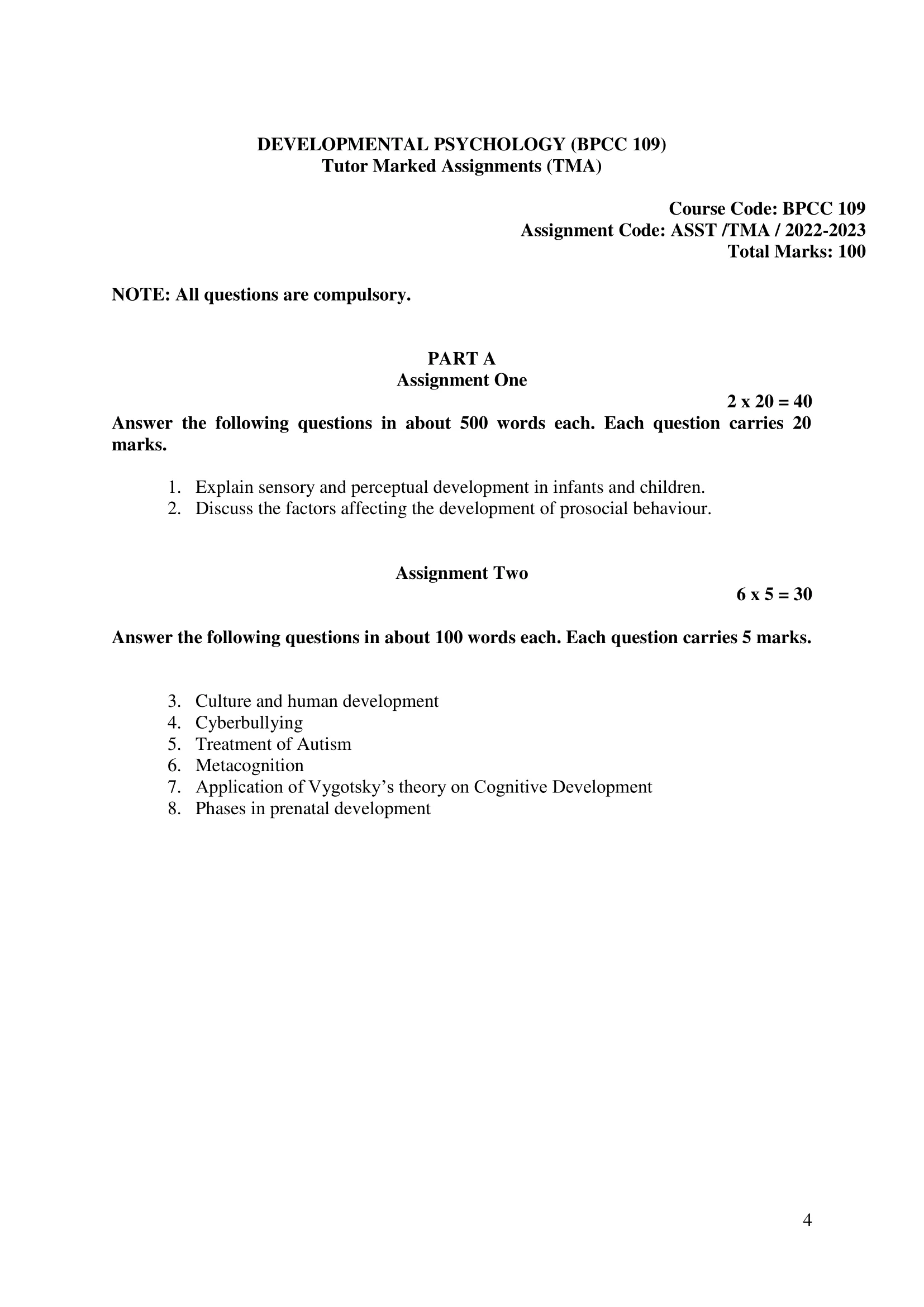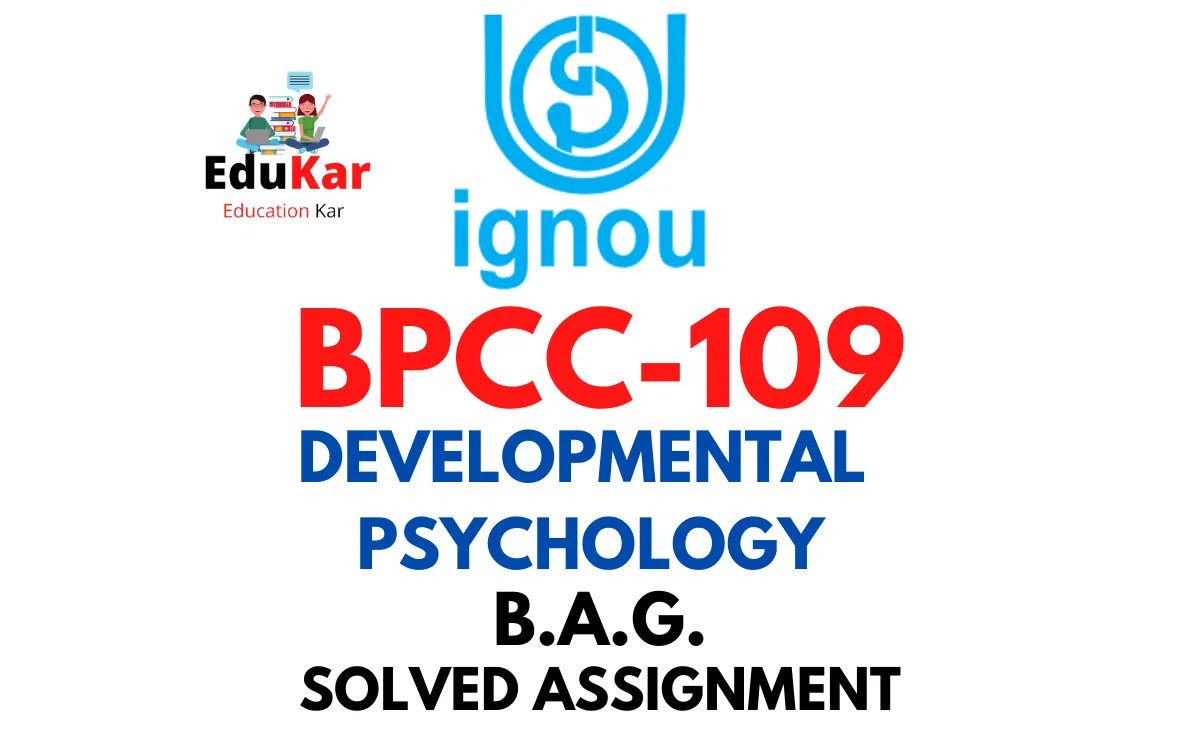
| Title | BPCC-109: IGNOU BAG Solved Assignment 2022-2023 |
| University | IGNOU |
| Degree | Bachelor Degree Programme |
| Course Code | BPCC-109 |
| Course Name | DEVELOPMENTAL PSYCHOLOGY |
| Programme Name | Bachelor of Arts (General) |
| Programme Code | BAG |
| Total Marks | 100 |
| Year | 2022-2023 |
| Language | English |
| Assignment Code | ASST /TMA / 2022-2023 |
| Last Date for Submission of Assignment: | For June Examination: 31st April For December Examination: 30th September |

Assignment One
Answer the following questions in about 500 words each. Each question carries 20
marks.
1. Explain sensory and perceptual development in infants and children.
Ans: Sensory and perceptual development refers to the process by which infants and children learn to receive, process, and interpret information from their surroundings through their senses. Sensory and perceptual development begins in utero and continues throughout childhood, influencing various aspects of cognitive, social, and emotional development.
During the prenatal period, sensory systems begin to develop, and sensory experiences can shape fetal behavior. For example, studies have shown that fetuses can recognize their mother’s voice and show preference for it over other voices. After birth, infants’ sensory systems continue to mature, and they start to integrate information from multiple senses, allowing them to form a more comprehensive understanding of the world around them.
Infants are born with a range of sensory capabilities, including vision, hearing, touch, taste, and smell, but they are not fully developed. Newborns have limited visual acuity, which gradually improves over the first few months of life. They also have a preference for high-contrast, simple patterns and shapes, which may help them to recognize faces and objects. Infants are also sensitive to sounds and can discriminate between different pitches, loudness, and speech sounds. They are also responsive to touch, and this can be seen through their ability to suckle, grasp, and orient themselves towards objects.
Perceptual development is the process of interpreting sensory information and making sense of the world. It is a complex process that involves attention, memory, and learning. Infants use their senses to gather information about their environment, and this information is integrated to form perceptual experiences. For example, they may recognize their mother’s face based on its features and shape, as well as its sound and smell. As they continue to explore their environment, infants learn to associate different sensory inputs with specific objects, actions, and events, forming more complex and integrated perceptual experiences.
As children develop, their sensory and perceptual abilities become more refined and sophisticated, allowing them to perceive more complex information and navigate more challenging environments. For example, they may develop the ability to discriminate between different colors, shapes, and sizes, as well as more abstract concepts such as depth perception, object permanence, and cause-and-effect relationships. They also become more adept at using their senses to guide their actions and movements, such as reaching for and grasping objects or moving through space.
2. Discuss the factors affecting the development of prosocial behaviour.
Ans: Prosocial behavior refers to voluntary actions that are intended to benefit others, such as sharing, helping, and cooperating. The development of prosocial behavior is influenced by a variety of factors, including genetic, neurological, social, and cultural factors. In this answer, we will discuss some of the most significant factors that affect the development of prosocial behavior.
- Genetics: Studies have shown that genetics play a role in the development of prosocial behavior. Research has identified specific genes that may be associated with prosocial behavior, such as the oxytocin receptor gene. However, the exact mechanisms by which genes influence prosocial behavior are not fully understood.
- Parenting: The parenting style and practices that children are exposed to can have a significant impact on the development of prosocial behavior. Children who grow up in families where parents model prosocial behavior and reinforce it are more likely to exhibit such behaviors themselves. Parenting practices that involve positive reinforcement and praise for prosocial behavior have been found to promote its development.
- Socialization: Socialization refers to the process by which children learn the norms, values, and expectations of their society or culture. Socialization can influence the development of prosocial behavior by providing children with opportunities to learn and practice prosocial behavior. Children who are exposed to prosocial models in their community or cultural setting are more likely to engage in prosocial behavior themselves.
- Empathy: Empathy is the ability to understand and share the feelings of others. It is a crucial factor in the development of prosocial behavior, as it allows children to recognize the needs and feelings of others and respond appropriately. Children who develop empathy are more likely to engage in prosocial behavior.
- Cognitive Development: As children’s cognitive abilities develop, they become better able to understand the consequences of their actions and the impact they can have on others. This awareness can influence their prosocial behavior, as they become more capable of considering the needs of others and making choices that benefit them.
- Peer Relationships: Peer relationships play a crucial role in the development of prosocial behavior. Children who have positive peer relationships are more likely to engage in prosocial behavior, as they learn the benefits of cooperating and helping others. Peer rejection or negative peer relationships can inhibit the development of prosocial behavior.
- Culture: Cultural factors can influence the development of prosocial behavior by providing different norms and expectations for behavior. For example, collectivist cultures may place more emphasis on cooperation and community, which may promote prosocial behavior, while individualistic cultures may value independence and self-reliance, which may discourage prosocial behavior.
Assignment Two
Answer the following questions in about 100 words each. Each question carries 5 marks.
1. Culture and human development
Ans: Culture and human development are intricately linked as culture provides the framework for human development. Culture influences the way we think, behave, and interact with others. It shapes our beliefs, values, and attitudes towards various aspects of life, such as education, family, religion, and gender roles. As we grow and learn, our culture becomes a part of our identity and influences our personality development. The transmission of cultural values from one generation to the next is a critical aspect of human development, as it helps to maintain social cohesion and stability. Understanding the impact of culture on human development is essential in developing effective policies and programs to promote human well-being.
2. Cyberbullying
Ans: Cyberbullying refers to the use of technology to harass, intimidate, or embarrass someone, usually through social media, online forums, or messaging apps. Unlike traditional bullying, cyberbullying can occur anonymously and can have a wider reach, making it more difficult to escape. Cyberbullying can have a serious impact on the victim’s mental health, including depression, anxiety, and even suicide. It is important to recognize the signs of cyberbullying and take action to prevent it. Parents, educators, and policymakers can help prevent cyberbullying by promoting online safety and providing resources and support for victims. It is also essential to teach children and young people about responsible online behavior and the potential consequences of cyberbullying. By working together, we can create a safer and more inclusive online environment.
3. Treatment of Autism
Ans: Autism spectrum disorder (ASD) is a complex neurological and developmental disorder that affects social interaction, communication, and behavior. While there is no cure for autism, there are various treatments and interventions that can help manage the symptoms and improve quality of life for individuals with autism.
Behavioral therapies, such as Applied Behavior Analysis (ABA) and Cognitive Behavior Therapy (CBT), are commonly used to help individuals with autism learn new skills, manage challenging behaviors, and improve communication and social interactions. These therapies may be delivered in individual or group settings, depending on the needs of the individual.
Medications may also be used to manage some of the symptoms of autism, such as anxiety, depression, and hyperactivity. However, medication should always be used under the guidance of a medical professional and should be combined with other therapies for the best outcomes.
In addition to these treatments, some alternative therapies, such as music therapy, art therapy, and animal-assisted therapy, may also be helpful for individuals with autism. However, it is important to note that the effectiveness of these therapies is not well-established and should be used in combination with evidence-based treatments.
4. Metacognition
Ans: Metacognition is the ability to think about one’s own thinking, learning, and problem-solving processes. It involves being aware of one’s thoughts, emotions, and behaviors and using this information to make more effective decisions and solve problems. Metacognition plays an important role in learning and academic success, as it helps individuals to plan, monitor, and evaluate their own learning processes.
There are several strategies that individuals can use to develop metacognitive skills. These include setting goals, monitoring progress, reflecting on one’s own learning, and seeking feedback from others. For example, setting clear learning goals can help individuals stay focused and motivated, while monitoring progress can help them identify areas for improvement. Reflecting on one’s own learning experiences can help individuals understand their own strengths and weaknesses and develop strategies for improvement. Seeking feedback from others, such as teachers or peers, can also help individuals gain a better understanding of their own learning processes and identify areas for improvement.
In the classroom, educators can help students develop metacognitive skills by providing opportunities for reflection, feedback, and self-assessment. For example, teachers may ask students to reflect on their own learning experiences or provide opportunities for peer feedback. By developing metacognitive skills, individuals can become more self-directed learners, better problem-solvers, and more effective decision-makers.
5. Application of Vygotsky’s theory on Cognitive Development
Ans: Vygotsky’s sociocultural theory of cognitive development emphasizes the role of culture and social interactions in shaping an individual’s cognitive development. According to Vygotsky, learning occurs through social interactions, and the social context in which learning occurs is critical in determining the cognitive development of an individual.
One application of Vygotsky’s theory is in the field of education. Vygotsky believed that learning should be based on the learner’s zone of proximal development (ZPD), which is the range of tasks that a learner can perform with assistance but cannot yet perform independently. Teachers can use this concept to provide appropriate support and scaffolding to students, helping them to learn and develop more effectively. Teachers can also use collaborative learning approaches, such as peer tutoring and group work, to encourage social interaction and promote learning.
Another application of Vygotsky’s theory is in the development of language skills. Vygotsky believed that language plays a central role in cognitive development, and that social interactions and language use can help to shape an individual’s thinking and reasoning processes. Teachers can use this insight to promote language development in their students, by encouraging meaningful communication and conversation in the classroom.
Vygotsky’s theory also has implications for technology use and digital learning. Vygotsky believed that tools and technologies can help to extend an individual’s cognitive abilities and enhance their learning experiences. In the digital age, educators can use technology to provide students with new and engaging learning experiences, and to support collaborative learning and social interaction.
6. Phases in prenatal development
Ans: Prenatal development is the process of growth and development that occurs from conception to birth. It is divided into three main phases: the germinal period, the embryonic period, and the fetal period. The germinal period is the first two weeks after conception, during which the zygote divides and forms a blastocyst, which implants into the uterine wall. The embryonic period is the second phase, lasting from the third week to the end of the eighth week, during which major organs and body systems form. The fetal period is the final phase, lasting from the ninth week until birth, during which organs and systems continue to mature, and the fetus grows in size and weight. Each phase is critical for healthy development, and environmental factors can impact fetal growth and health.
How to Download BPCC-109 Solved Assignment?
You can download it from the www.edukar.in, they have a big database for all the IGNOU solved assignments.
Is the BPCC-109 Solved Assignment Free?
Yes this is absolutely free to download the solved assignment from www.edukar.in
What is the last submission date for BPCC-109 Solved Assignment?
For June Examination: 31st April, For December Examination: 30th October
